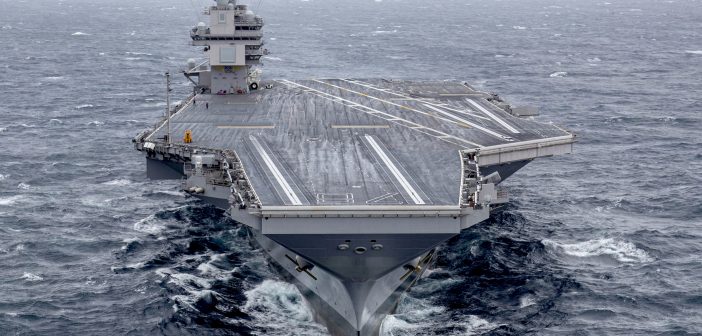WASHINGTON – The US Navy’s top acquisition official was upbeat as he met with media Monday in his Pentagon office. He was just back after a quick trip to the long-troubled aircraft carrier Gerald R Ford (CVN 78), now underway off the Virginia coast on sea trials after 15 months in a shipyard.
“There are about 3,000 motivated folks on the ship,” James “Hondo” Geurts told reporters. “It was the culmination of an action-packed availability,” he said, using the Navy term for a major maintenance period. “Closing that out was what you want to see out of a high-performing, integrated team. It was exciting to see.”
The return of the Ford to sea on Oct. 25 is not the only major event happening with the carrier program. Tuesday morning Oct. 29 the John F. Kennedy (CVN 79), second ship in the class, was scheduled to go afloat for the first time at Newport News Shipbuilding, the sprawling Virginia shipyard of Huntington Ingalls Industries (HII). Shortly after the Kennedy is moved to a fitting-out-pier, the third ship, Enterprise (CVN 80), will begin to be assembled.
Geurts said the Kennedy would have its ceremonial christening event on Dec. 7, when ship’s sponsor Caroline Kennedy will officially name the second aircraft carrier to carry her father’s name.
The Navy, its shipbuilders and its contractors now are in a good place on the carrier program, Geurts said.
“My worry is how we stay on this upward trajectory, where my side and the shipyard and the Navy are all working together. It’s a big, complicated ship, there are lots of things we’re tracking.
“My focus is on not just that one ship, but the entire class of carriers,” he added. “We have to make sure we’re set up for 50 years of each of these ships” – the planned lifetime of an aircraft carrier – “not just on the next event.”
But for now the Ford is commanding the most attention. Geurts ticked off a number of accomplishments since the ship began post-overhaul sea trials.
“We worked the elevators,” he said, referring to the famously troubled Advanced Weapon Elevators (AWEs) using magnetic technology. “We certified and turned over [to the crew]four” of the ship’s eleven AWEs. We cycled them 94 times just on Sunday. HII was on board working the other elevators. Three of those lower elevators are in varying states of final construction.”
Geurts added that the four operationally-certified elevators are the three upper-stage elevators plus a utility elevator also used for medical evacuations. Seven more lower-stage elevators continue to receive attention, with three of those nearing certification, he said. But it will still be about a year and a half before all 11 elevators are certified and in full operation, he cautioned.
Of the ship’s other systems, the Dual Band Radar (DBR), a unique feature on the Ford, “has been up and operating while at sea, tracking targets. Feeling pretty good about that,” he said.
Geurts also said he was pleased with progress on the Electromagnetic Aircraft Launch System (EMALS) and Advanced Arresting Gear (AAG), two more key new technologies on the carrier. New elements have been put in place on the arresting gear, he said, and land-based testing of the systems continues at an ever-growing pace. Flight operations on the Ford, he said, should resume shortly after the turn of the year, adding the goal is to work the system hard.
The ship’s propulsion system already is being checked out, Geurts noted.
“We’ve been at full power, we’ve tested the [main shaft]bearings, we’ve tested the throttles, everything looks solid,” he said, knocking a wooden table while adding the main turbine generators and the propulsion plant also look good.
Geurts expressed confidence that a dispute between HII and General Electric about responsibilities with problems in the ship’s propulsion plant will be worked out between the companies, with no additional costs to the Navy.
A congressionally-imposed cost cap remains in place on the Ford, however, and the Navy in late September received permission to add $197 million to the ship’s acquisition cost, for a new total of $13.224 billion. The new monies were needed, the Navy said in a statement, “in order to correct deficiencies identified during testing, to ensure the safety of the ship and personnel, and to deliver an operational ship to the fleet.”
The additional money also includes more for work on the elevators. The new money will come from the current 2019 budget and the future fiscal 2020 and 2021 budgets.
Asked for examples of where the cost cap might have prevented needed work from being done in a timely fashion, Geurts pointed to “some of the prototyping, some of the risk reduction.
“With a cost cap you can actually cause a behavior that suppresses information,” he said. “People don’t want to bring bad news to the boss. I’m much more for transparency so you can make decisions.
“I just worry sometimes the intended behavior might not be the resultant behavior,” he added. “Cost cap as a management mechanism may not be the best way to drive that.”
During the Ford’s post-shakedown availability – a planned post-delivery shipyard period where Navy ships return to the yard to correct deficiencies discovered in their initial, shakedown, period and receive additional work, Newport News shipbuilders essentially defined a new shipyard trade of specialists working on the advanced elevators, which will be installed on the Kennedy, Enterprise and all future carriers in addition to the Ford.
“The shipyard has created a kind of trade school for elevators now,” Geurts said. “I am pretty optimistic that HII is setting up almost a specific trade, with specific training and a specific focus on this. That work force can now move from ship to ship and kind of be the AWE super geniuses as opposed to having to retrain tradesmen in this rather unique skill.”
A full, land-based test site is also being built by the Navy in Philadelphia to further test the technology.
“I think that’s where we missed it,” Geurts said of the AWE problems on the Ford. “The technology itself is not that exotic. The construction and getting the construction sequence right and having that planned very, very specifically, is what we really learned on 78.
“The other challenge is there isn’t a huge degree of commonality between the eleven elevators, so you don’t really get as much learning between elevators on the single ship, you get learning on the elevators across a class of ships.”
With the Ford back at sea on its post-delivery test and testing cycle, the plan is to keep the ship at sea “roughly half the time,” Geurts said.
That approach is much more aggressive than the Ford’s initial operating period between its delivery in May 2017 to entering the shipyard in June 2018, during which the ship operated at sea for only 81 days.
Geurts also pledged much improved media access to the carrier, promising to get reporters out on the ship at sea, something which did not happen during the initial operating period.
Throughout the discussion, Geurts sounded positive notes about the carrier program.
“We’ve got a lot of work to do. Are we gonna have issues? You betcha,” he said.
“We’re making pretty good steam right now. Our big challenge is to continue to do this at the speed of relevance, and I’m pretty happy with where we are, and pressing hard to get better.”
Contact Chris Cavas at chriscavas@gmail.com



